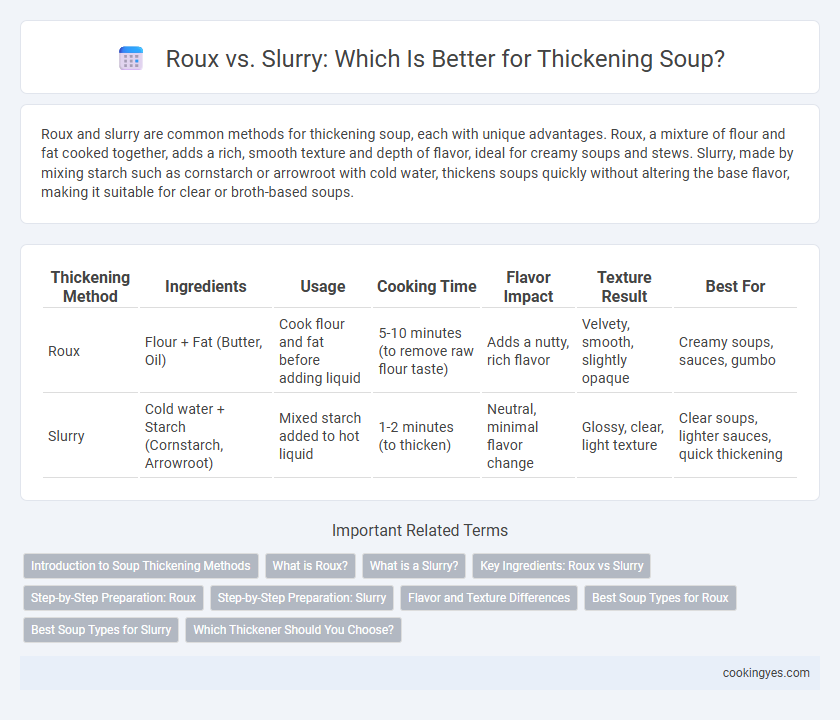Roux and slurry are common methods for thickening soup, each with unique advantages. Roux, a mixture of flour and fat cooked together, adds a rich, smooth texture and depth of flavor, ideal for creamy soups and stews. Slurry, made by mixing starch such as cornstarch or arrowroot with cold water, thickens soups quickly without altering the base flavor, making it suitable for clear or broth-based soups.
Table of Comparison
| Thickening Method | Ingredients | Usage | Cooking Time | Flavor Impact | Texture Result | Best For |
|---|---|---|---|---|---|---|
| Roux | Flour + Fat (Butter, Oil) | Cook flour and fat before adding liquid | 5-10 minutes (to remove raw flour taste) | Adds a nutty, rich flavor | Velvety, smooth, slightly opaque | Creamy soups, sauces, gumbo |
| Slurry | Cold water + Starch (Cornstarch, Arrowroot) | Mixed starch added to hot liquid | 1-2 minutes (to thicken) | Neutral, minimal flavor change | Glossy, clear, light texture | Clear soups, lighter sauces, quick thickening |
Introduction to Soup Thickening Methods
Roux and slurry are fundamental soup thickening methods that enhance texture and flavor by incorporating starch-based ingredients. Roux combines equal parts fat and flour cooked together to create a smooth, rich base that gradually thickens soups as it simmers. Slurry, made from mixing cold water with cornstarch or flour, quickly thickens soups when added towards the end of cooking without altering the soup's underlying taste.
What is Roux?
Roux is a classic thickening agent made by cooking equal parts flour and fat, typically butter, until it forms a smooth paste that enhances soup texture and flavor. It provides a rich, velvety consistency and imparts a subtle nutty taste, depending on the cooking time and color of the roux. Roux differs from slurry by offering more depth and stability in soups, especially in creamy or hearty recipes.
What is a Slurry?
A slurry is a mixture of cold water and starch, typically cornstarch or flour, used to thicken soups and sauces without altering their flavor. When added to hot liquid, the starch granules swell and absorb water, creating a smooth, glossy texture. Slurries are ideal for quick thickening and maintaining clarity in broth-based soups.
Key Ingredients: Roux vs Slurry
Roux relies on equal parts flour and fat, usually butter, cooked together to create a rich, smooth base that enhances soup flavor while thickening. Slurry uses a mixture of cold water and starches like cornstarch or potato starch, offering a quick, clear thickening without adding extra fat. Choosing between roux and slurry depends on desired texture and cooking time, with roux providing a creamy, velvety consistency and slurry giving a glossy, translucent finish.
Step-by-Step Preparation: Roux
To prepare a roux for soup thickening, melt equal parts butter and flour in a saucepan over medium heat, stirring constantly to form a smooth paste. Cook the mixture until it reaches a desired color, ranging from pale blonde for light soups to deep brown for richer flavors, which enhances the final soup's depth. Gradually whisk in stock or broth to the roux, ensuring a lump-free, velvety texture that thickens the soup evenly.
Step-by-Step Preparation: Slurry
To prepare a slurry for thickening soup, combine equal parts cold water and cornstarch or flour in a small bowl, stirring until smooth and free of lumps. Gradually whisk the slurry into the simmering soup, allowing it to cook for several minutes to activate the thickening agents and achieve the desired consistency. Monitor the soup's texture closely, as overcooking can break down the starches and reduce thickness.
Flavor and Texture Differences
Roux, made from cooked flour and fat, imparts a rich, nutty flavor and creates a smooth, velvety texture ideal for creamy soups. Slurry, a mixture of cold water and starch such as cornstarch or potato starch, thickens quickly but offers a more neutral taste and a slightly gelatinous, less creamy texture. Choosing between roux and slurry depends on the desired depth of flavor and mouthfeel in the finished soup.
Best Soup Types for Roux
Roux is ideal for creamy, rich soups such as bisques, chowders, and veloute-based soups due to its ability to create a smooth, velvety texture and enhance flavor through the cooked flour. Thick soups with dairy or butter bases, like clam chowder or creamy mushroom soup, benefit from a roux's stable and flavorful thickening properties. Unlike slurry, which is preferred for clear or broth-based soups, roux provides a deeper, more complex consistency perfect for hearty, dense soups.
Best Soup Types for Slurry
Slurry thickening works best for clear soups and broths such as chicken noodle, vegetable, and miso soups, where preserving a transparent appearance is essential. Cornstarch or arrowroot-based slurries integrate smoothly without clouding the soup, maintaining a light texture and enhancing mouthfeel without altering flavor. Soups with delicate ingredients or quick-cooking proteins benefit from slurry thickening as it allows precise control over consistency without overcooking.
Which Thickener Should You Choose?
Roux and slurry are both effective soup thickeners, but roux, made by cooking flour and fat together, provides a richer flavor and a smooth, velvety texture ideal for creamy soups and sauces. Slurry, composed of cornstarch or arrowroot mixed with cold water, is best for quick thickening, producing a clear, glossy finish without altering the base flavor, making it suitable for broth-based soups and stir-fries. Choose roux for depth and complexity, while slurry is preferred for a fast, neutral-thickening option.
Roux vs Slurry for soup thickening Infographic

 cookingyes.com
cookingyes.com